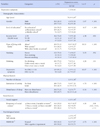Abstract
Purpose
This study was done to investigate the factors which influence depressive symptoms in older people.
Methods
This was a cross-sectional study. Data were collected through questionnaires from 393 older people. Data analysis was done with SPSS/WIN 17.0.
Results
The prevalence of depression for elders was 14.8%. Living with family and level of education were significant factors related to depressive symptoms identified through multiple logistic regression analysis. After adjusting for several confounding factors, the factors related to depressive symptoms were number of chronic diseases, social support, frequency of social contact, sleep disturbance, and stress.
Conclusion
Results of this study indicate that there is a need to construct and implement an integrated preventive program for depression which deals with care for chronic disease, reduction of stress, increased connection with a community network for social support and management of sleep disturbances.
Figures and Tables
References
2. Cho MJ, Kim KH. Diagnosis validity of the CES-D (Korean Version) in the assessment of DSM-III-R Major Depression. J Korean Neuropsychiatr Assoc. 1993. 32:381–399.
3. Cohen S, Hoberman H. Positive events and social supports of buffer of life change stress. J Appl Soc Psychol. 1983. 13:99–125.
4. Chon BJ. Self-esteem: A test of its measurability. Yonsei Nonchong. 1974. 10:109–129.
5. Cole MG, Dendukuri N. Risk factors for depression among elderly community subjects: A systematic review andmeta-analysis. Am J Psychiatry. 2003. 160:1147–1156.

6. Frank SH, Zyznaski SJ. Stress in clinical setting: The brief encounter psychosocial instrument. J Fam Pract. 1988. 26:533–539.
7. Gatz JL, Tyas SL, John P, Montgomery P. Do depressive symptoms predict Alzheimer's disease and dementia? J Gerontol A Biol Sci Med Sci. 2005. 60:744–747.

8. Health Insurance Policy Research Institute National Health Insurance
Corporation [NHIC]. The Press release. 2013. Retrieved April 16, 2013. from http://www.nhic.or.kr/cms/board/board/Board.jsp?act=VIEW&communityKey=B0039&boardId=22642.
9. Jang MH, Won JS. Association of anger and anger expression, social support, self-esteem, and depression in elderly. J Korean Acad Psychiatr Ment Health Nurs. 2009. 18:259–268.
10. Kim CG, Park SM. Gender difference in risk factors for depression in community-dwelling elders. J Korean Acad Nurs. 2012. 42:136–147.

11. Lee DY, Lee KU, Lee JH, Kim KW, Jhoo JH, Youn JH, et al. A normative study of the mini-mental state examination in the Korean elderly. J Korean Neuropsychiatr Assoc. 2002. 41:508–525.
12. Lee KS, Cheong HK, Oh BH, Hong CH. Comparison of the validity of screening tests for dementia and mild cognitive impairment of the elderly in a community: K-MMSE, MMSE-K, MMSE-KC, and K-HDS. J Korean Neuropsychiatr Assoc. 2009. 48:61–69.
13. Lee PS, Lee YM, Lim JY, Hwang RI, Park EY. The relationship of stress, social support and depression inthe elderly. J Korean Acad Nurs. 2004. 34:477–483.

14. Lee YH, Shin MH, Kweon SS, Choi SW, Ryu SY, Rhee JA, et al. Prevalence and correlates of depression among the elderly in an urban community. J Agric Med Community Health. 2008. 33:303–315.

16. Moon MJ. Factors influencing depression in elderly people living at home. J Korean Acad Nurs. 2010. 40:542–550.

17. Oh DH, Kim SA, Lee HY, Seo JY, Choi BY, Nam JH. Prevalence and correlates of depressive symptoms in Korean adults: Results of community health survey. J Korean Med Sci. 2013. 28:128–135.

18. Ohayon MM, Hong SC. Prevalence of major depressive disorder in the general population of South Korea. J Psychiatr Res. 2006. 40:30–36.

19. Park JH, Kim KW. A review of the epidemiology of depression in Korea. J Korean Med Assoc. 2011. 54:362–369.

20. Park JH, Lee JJ, Lee SB, Huh Y, Choi EA, Youn JC, et al. Prevalence of major depressive disorder and minor depressive disorder in an elderly Korean population: Results from the Korean longitudinal study on health and aging (KLoSHA). J Affect Disord. 2010. 125:234–240.

21. Park MH, Choi SR, Shin AM, Koo CH. Analysis of the characteristics of the older adults with depression using data mining decision tree analysis. J Korean Acad Nurs. 2013. 43:1–10.

22. Radloff LS. The CES-D scale: A self report depression scale for research in the general population. Appl Psychol Meas. 1977. 1:385–401.
23. Rosenberg M. Society and the adolescent self-image. 1965. Princeton, NJ: Princeton University Press.
24. Seo JM, Kim MH, Kim JS. Discriminating power of depression of elderly women by arthralgia, physical function and physical self-efficacy. J Korean Acad Psychiatr Ment Health Nurs. 2006. 15:237–245.
25. Shin KR, Kang YH, Kim MY, Jung DK, Lee E. Prediction of depression among elderly with mild cognitive impairment living in the community. Korean J Adult Nurs. 2012. 24:171–182.

26. Statistics Korea. 2010 aging statistics. 2010. 09. 29. Retrieved January 9, 2012. from http://kostat.go.kr/portal/korea/kor_nw/2/1/index.board?bmode=read&aSeq=250718&pageNo=7&rowNum=10&amSeq=&sTarget=&sTxt=.
27. Ustün TB, Ayuso-Mateos JL, Chatterji S, Maters C, Murray CJ. Global burden of depressive disorders in the year 2000. Br J Psychiatry. 2004. 184:386–392.

28. Won JS, Kim KH. Evaluation of cognitive functions, depression, life satisfaction among the elderly receiving visiting nursing services. J Korean Acad Nurs. 2008. 38:1–10.

29. Yao KW, Yu S, Cheng SP, Chen IJ. Relationships between personal depression and social network factors and sleep quality in community-dwelling older adults. J Nurs Res. 2008. 16:131–138.

30. Yim JH, Bae JM, Choi SS, Kim SW, Hwang HS, Huh BY. The validity of modified Korean-translated BEPSI (Brief Encounter Psychosocial Instrument) as instrument of stress measurement in outpatient clinic. J Korean Acad Fam Med. 1996. 17:42–53.




 PDF
PDF ePub
ePub Citation
Citation Print
Print




 XML Download
XML Download